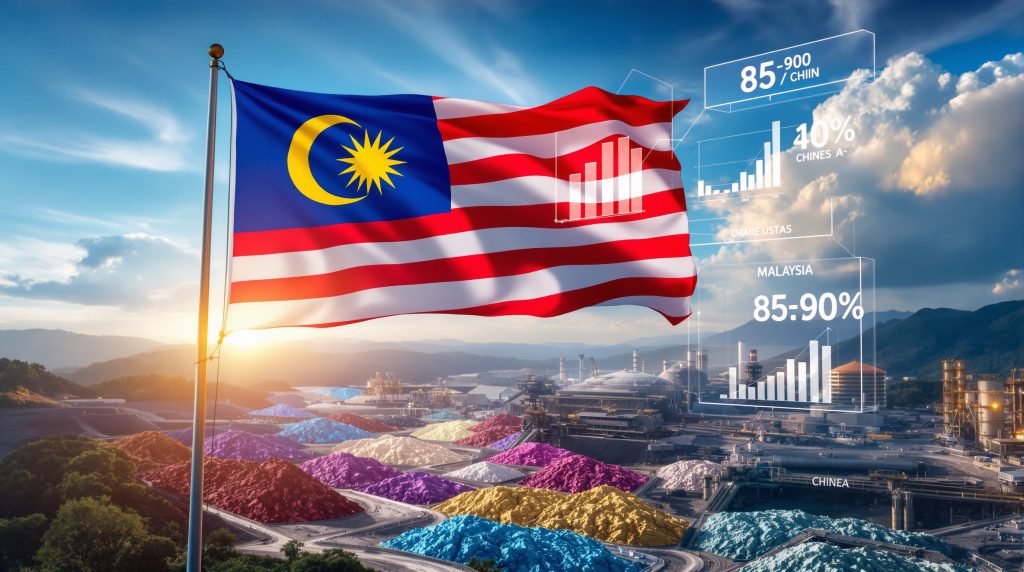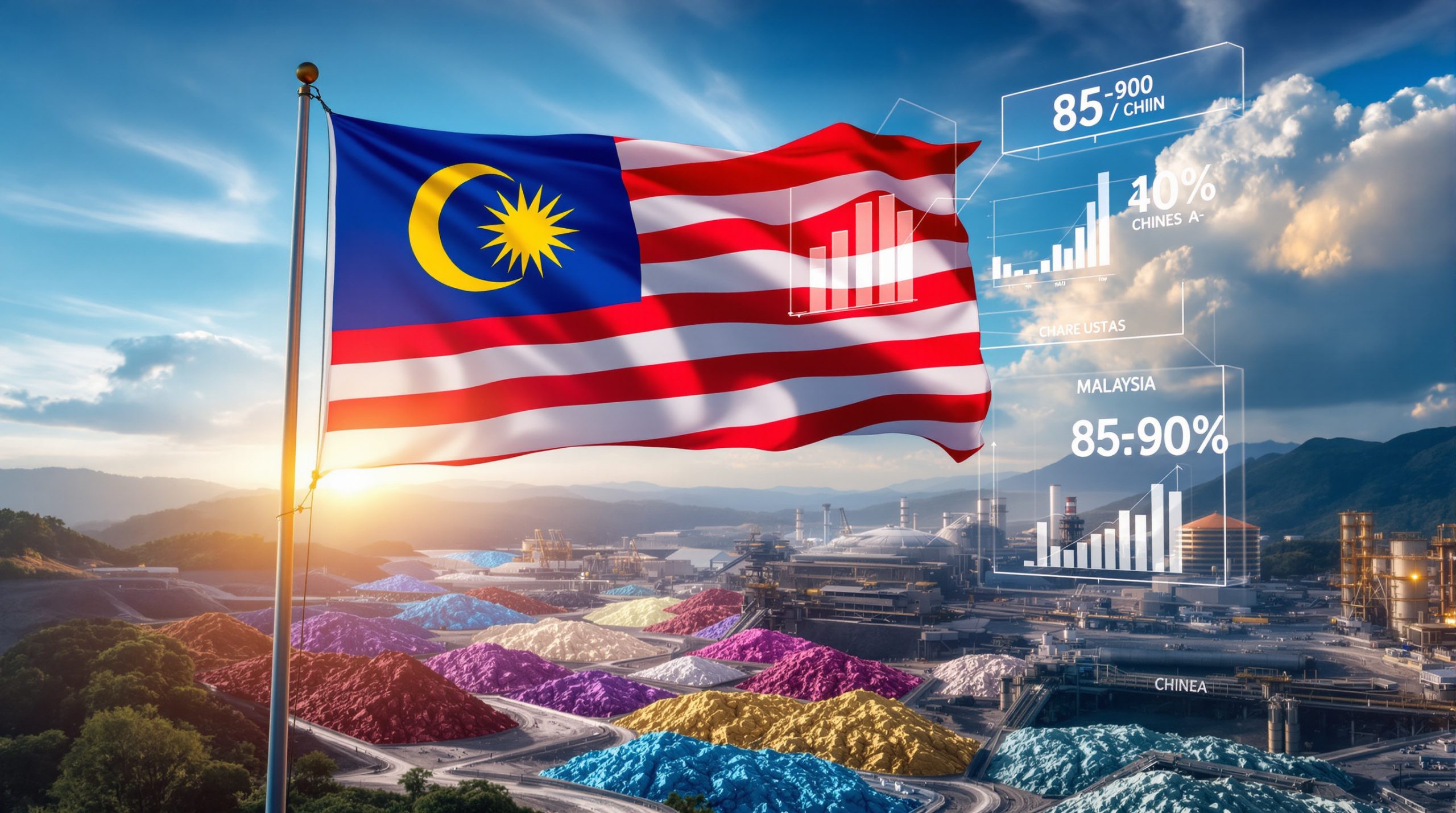Strategic Diversification Versus Operational Reality in Global Rare Earth Supply Chains
The accelerating global transition toward clean energy technologies has intensified geopolitical competition for critical mineral supply chains, with rare earth elements positioned at the epicenter of this strategic rivalry. While policymakers advocate for supply chain diversification away from Chinese dominance, operational realities on the ground often diverge sharply from diplomatic announcements and memorandums of understanding.
Malaysia's emerging role in this landscape exemplifies the complex dynamics between strategic intentions and market fundamentals, where established commercial relationships and technical dependencies frequently override geopolitical preferences.
What Makes Malaysia's Rare Earth Sector a Strategic Battleground?
Critical Minerals Supply Chain Vulnerabilities
China's overwhelming control of global rare earth processing capabilities represents one of the most significant supply chain concentration risks in the modern economy. Current estimates indicate Chinese entities control between 85-90% of global refined rare earth production capacity, creating vulnerabilities that extend far beyond raw material extraction into the sophisticated midstream operations that determine global access to separated rare earth oxides and advanced magnetic materials.
This concentration becomes particularly acute when examining the technical complexity required for rare earth separation and metallisation. Unlike many other mineral commodities where processing technology is widely distributed, rare earth refining requires specialised chemical knowledge, precise environmental controls, and substantial capital investment that few nations have successfully developed independently.
Malaysia's positioning as a potential alternative processing hub reflects broader Western strategic initiatives to establish rare earth capabilities outside Chinese influence. However, the gap between policy aspirations and operational reality remains substantial, with existing Malaysian operations continuing to channel their output through Chinese midstream infrastructure despite years of international investment and diplomatic engagement. Furthermore, critical minerals energy transition initiatives face significant implementation challenges.
Geopolitical Stakes in Southeast Asian Critical Minerals
The strategic importance of Southeast Asian rare earth development extends beyond simple supply diversification to encompass broader questions of technological sovereignty and industrial policy effectiveness. Recent Trump's minerals order emphasises the urgency of establishing alternative value chains that could reduce Western dependence on Chinese processing capabilities during potential supply disruptions.
Chinese Belt and Road investments in mineral infrastructure throughout the region create competing frameworks for regional development, often providing more immediate capital availability and technical expertise than Western alternatives. These investments frequently include comprehensive packages covering extraction, processing, and market access that prove attractive to developing nations seeking rapid economic development.
Technology transfer dynamics in rare earth processing remain particularly challenging because the most valuable intellectual property resides in separation chemistry and metallisation techniques rather than basic extraction methodologies. Countries hosting foreign rare earth operations often find that operational knowledge remains compartmentalised within foreign management structures, limiting domestic capability development even after years of facility operations.
How Does Southern Alliance Mine Fit Into Malaysia's Rare Earth Landscape?
Operational Scale and Production Metrics
Malaysia's Southern Alliance Mine China connection operates as the country's primary commercial-scale rare earth extraction facility, though specific production volumes remain closely held by the operating consortium. The facility's strategic significance derives not from its absolute production capacity but from its role as Malaysia's most substantial rare earth extraction operation with established midstream connections.
| Operation | Primary Output | Market Destination | Ownership Structure |
|---|---|---|---|
| Southern Alliance Mine | Rare Earth Carbonates | 100% China | MCRE Resources (40%) + Partners |
| Lynas Pahang Processing | Separated RE Oxides | Global Markets | Australian-owned |
| Regional Exploration Projects | Development Stage | TBD | Mixed Ownership |
The mine's positioning within Malaysia's broader rare earth economy highlights the country's limited diversified production base. Unlike nations with multiple large-scale operations, Malaysia's rare earth sector remains concentrated around relatively few facilities, making individual operations particularly influential in determining overall sector orientation and strategic relationships.
Ownership Structure and Strategic Partnerships
MCRE Resources maintains a 40% stake in Southern Alliance Mine operations, with additional Chinese investment through Qingdao Jifeng holding an estimated 36% position. This ownership structure reflects the complex international partnerships characteristic of Southeast Asian mineral development, where domestic companies often collaborate with foreign entities possessing superior technical capabilities and market access.
The involvement of Chinese investors extends beyond simple capital provision to encompass operational management, technical expertise, and critical market relationships. These partnerships create integrated value chains that span from extraction through processing and final market placement, often making individual operations difficult to reorient toward alternative customers or technical frameworks.
Government-linked company involvement through entities like PETRONAS and Khazanah indicates official Malaysian interest in maintaining strategic oversight of rare earth development. However, the practical influence of these relationships on day-to-day operations varies considerably based on specific contractual arrangements and operational agreements.
Export Destination Analysis
Southern Alliance Mine's 100% China-facing customer base represents the most significant factor determining its strategic orientation and operational decision-making framework. This complete market dependence creates powerful incentives to maintain close relationships with Chinese midstream processors and conform to Chinese quality specifications and delivery requirements.
Rare earth carbonate exports to Chinese processing facilities integrate Malaysian extraction operations directly into Chinese value chains, where further separation and metallisation occur under Chinese technical control. This positioning means that despite Malaysian extraction, the value-added processing that determines final product characteristics and applications remains within Chinese industrial infrastructure.
Supply chain integration with Chinese midstream facilities extends beyond simple customer relationships to encompass technical specifications, quality standards, logistics coordination, and payment terms that collectively create operational dependencies difficult to rapidly restructure toward alternative markets. In addition, recent developments covered in CRM facility insights highlight Europe's attempts to reduce similar dependencies.
Why Haven't Technology Transfers Materialised Despite Years of Operations?
The "Black Box" Technology Challenge
Separation and metallisation know-how retention by Chinese partners reflects deliberate strategies to maintain technological advantages rather than accidental knowledge compartmentalisation. The most valuable intellectual property in rare earth processing lies in the precise chemical processes, equipment specifications, and operational parameters required to achieve high-purity separated oxides from mixed rare earth feeds.
Limited Malaysian technical capability development occurs despite facility operations because critical process steps remain under foreign management with Malaysian personnel often excluded from key operational decision-making and technical optimisation activities. This structural arrangement prevents organic knowledge transfer even when facilities operate for extended periods.
Comparison with Australian Lynas operations in Pahang reveals that foreign facility presence alone does not guarantee technology transfer without specific contractual obligations or government requirements mandating knowledge sharing. Lynas has operated Malaysian processing facilities for over a decade without establishing comprehensive domestic technical capabilities independent of Australian management and expertise.
Infrastructure Dependencies
Chemical supply sourcing patterns from China create ongoing operational dependencies that extend beyond initial facility construction into continuous operation requirements. Specialised chemicals required for rare earth separation often require specific purity levels and compositions available primarily from Chinese suppliers with established production capabilities.
Processing equipment procurement relationships frequently involve proprietary technologies and maintenance requirements that necessitate ongoing relationships with original equipment manufacturers, typically Chinese entities in the case of rare earth processing equipment. These relationships create natural barriers to technology independence and alternative supplier development.
Technical expertise and operational management structures often remain dominated by foreign personnel in key positions, with domestic staff concentrated in support functions rather than core technical roles. This arrangement limits knowledge accumulation within Malaysian institutions and reduces the likelihood of developing independent operational capabilities over time.
What Do Recent High-Level Meetings Signal About Strategic Direction?
China Rare Earth Group Engagement Analysis
Recent high-level meetings between China Rare Earth Group representatives and Malaysian government officials demonstrate Beijing's commitment to maintaining operational influence despite competing diplomatic overtures from other nations. These engagements occur at levels involving Malaysia's Ministry of Natural Resources and Sustainability, indicating official government recognition of the strategic importance of rare earth relationships.
The coordination of multiple Malaysian government agencies including MITI, MIDA, and sovereign entities like PETRONAS alongside Chinese rare earth representatives indicates that rare earth cooperation transcends simple commercial relationships to encompass broader strategic coordination frameworks.
The timing of these meetings, occurring amid discussions of US-Malaysia cooperation agreements, suggests deliberate Chinese efforts to reinforce existing relationships and potentially counter alternative partnership development. Such diplomatic coordination reflects the high-level strategic importance both nations place on maintaining established rare earth cooperation frameworks.
Government Agency Coordination
Ministry of Natural Resources and Sustainability involvement indicates that rare earth relationships fall under natural resource security considerations rather than routine commercial oversight. This positioning suggests Malaysian recognition that rare earth supply chains involve strategic resource management beyond typical foreign investment frameworks.
MITI, JMG, and MIDA participation patterns reflect the multi-dimensional nature of rare earth cooperation, encompassing trade policy, geological assessment, and investment facilitation activities. This comprehensive agency involvement indicates that rare earth relationships require coordination across multiple government functions rather than single-ministry oversight.
PETRONAS and Khazanah strategic interest indicators suggest that Malaysian sovereign entities view rare earth development as sufficiently important to warrant direct engagement rather than delegation to purely private sector management. Consequently, these relationships may provide Malaysia with additional leverage and oversight capabilities in managing foreign partnerships.
How Substantial Are US-Malaysia Critical Minerals Agreements?
MOU Content Analysis Framework
Recent US-Malaysia memorandums of understanding regarding critical minerals cooperation utilise diplomatic language emphasising "supporting value-chain development" and "encouraging investment" without specifying binding commitments, financial mechanisms, or concrete implementation timelines. This vague terminology contrasts sharply with the specific operational relationships and financial flows characteristic of existing Chinese partnerships.
| Agreement Element | US-Malaysia MOU | Chinese Partnerships |
|---|---|---|
| Financial Commitments | Unspecified | Operational Capital Deployed |
| Technology Transfer | Aspirational Language | Active Operations |
| Market Access | Diplomatic Encouragement | Existing Customer Relationships |
| Implementation Timeline | No Specific Dates | Ongoing Operations |
The absence of specific project timelines, funding mechanisms, or binding obligations in these agreements suggests they function more as diplomatic signalling than operational realignment frameworks. Without concrete commitments comparable to existing Chinese relationships, these MOUs appear insufficient to alter established commercial relationships and technical dependencies.
Implementation Gap Assessment
Enforcement and compliance monitoring challenges emerge from the voluntary nature of most MOU provisions, which typically lack the binding legal frameworks necessary to compel specific actions or investments. Unlike commercial contracts with defined obligations and remedies, diplomatic MOUs often serve symbolic functions without creating actionable commitments.
Limited financial backing mechanisms represent perhaps the most significant implementation constraint, as meaningful supply chain diversification requires substantial capital investments in processing infrastructure, technical expertise development, and market relationship establishment. Without dedicated funding programmes comparable to Chinese investment levels, US cooperation agreements struggle to compete with existing operational realities.
The gap between diplomatic announcements and operational implementation becomes particularly evident when examining specific facility development, technology transfer programmes, and market access initiatives that would be required to meaningfully alter existing supply chain relationships. Moreover, the broader critical minerals strategy faces similar implementation challenges across multiple nations.
Malaysian Hedging Strategy Indicators
Diplomatic engagement patterns with both superpowers reveal Malaysian preferences for maintaining operational flexibility rather than exclusive alignment with either Chinese or US frameworks. This hedging approach allows Malaysia to pursue beneficial relationships with multiple partners while avoiding commitments that might preclude alternative opportunities.
Economic relationship maintenance priorities appear to favour existing operational partnerships that provide immediate economic benefits over speculative future arrangements that lack concrete implementation frameworks. This practical approach reflects Malaysian recognition that established commercial relationships provide more reliable economic value than diplomatic commitments without binding obligations.
Strategic autonomy preservation tactics include maintaining government oversight through sovereign entity involvement while avoiding exclusive arrangements that might limit future partnership flexibility. This approach allows Malaysia to benefit from foreign investment and expertise while preserving decision-making independence regarding future strategic relationships.
What Are the Long-Term Implications for Global Rare Earth Supply Chains?
Scenario Modelling: Continued Chinese Integration
Production capacity expansion under Chinese partnerships represents the most likely near-term scenario based on existing operational relationships and investment patterns. Chinese entities possess established technical capabilities, market relationships, and financial resources necessary to support rapid capacity development, making continued integration the path of least resistance for Malaysian operations.
Technology transfer acceleration possibilities under deepened Chinese cooperation could provide Malaysia with access to midstream processing capabilities currently unavailable through alternative partnerships. However, such transfer would likely occur within framework agreements that maintain Chinese strategic control over critical technological components and market access.
Regional supply chain consolidation effects from enhanced Chinese integration could strengthen overall Asian rare earth processing capabilities while potentially reducing Western access to diversified supply sources. This outcome would reinforce existing concentration patterns despite diplomatic efforts to encourage alternative development pathways.
Scenario Modelling: US Partnership Development
Alternative processing infrastructure requirements for meaningful US partnership would necessitate substantial capital investments in separation and metallisation capabilities currently absent from Malaysian operations. Developing such capabilities would require multi-billion dollar investments and several years of construction and commissioning activities.
Investment capital mobilisation needs for US partnership implementation would likely exceed current US government critical minerals funding programmes, requiring either substantial private investment or expanded government support mechanisms. The scale of required investment may prove prohibitive without dedicated strategic funding comparable to Chinese Belt and Road infrastructure programmes.
Timeline for meaningful supply chain diversification through US partnerships appears to extend beyond immediate policy cycles, requiring sustained political commitment across multiple administrations to achieve operational significance. Such long-term commitments face political sustainability challenges in democratic systems with regular leadership transitions.
Scenario Modelling: Malaysian Multi-Partner Strategy
Balanced engagement with multiple technology providers could allow Malaysia to access diverse technical capabilities while maintaining strategic independence from exclusive arrangements. This approach would require sophisticated diplomatic and commercial management to balance competing interests and avoid conflicts between partners.
Risk mitigation through diversified partnerships offers theoretical advantages but may prove difficult to implement practically given the integrated nature of rare earth value chains and the competitive dynamics between major powers. Partners may require exclusive arrangements or preferential access as conditions for significant investment or technology transfer.
Sovereign capability development pathways under multi-partner arrangements would need to emphasise Malaysian institutional development and knowledge accumulation rather than simple foreign operation hosting. Furthermore, achieving genuine capability independence would require sustained domestic investment in technical education, research infrastructure, and industrial development programmes.
How Do Other Regional Players Factor Into This Competition?
ASEAN Critical Minerals Coordination
Thailand's parallel engagement with US initiatives demonstrates regional patterns of diplomatic hedging while maintaining operational relationships with Chinese partners. Thai critical minerals development follows similar patterns to Malaysian approaches, accepting US diplomatic overtures while preserving established commercial relationships that provide immediate economic benefits.
Vietnam's rare earth development strategies reflect more assertive government intervention in foreign partnership management, potentially offering alternative models for balancing foreign investment with domestic capability development. Vietnamese approaches emphasise state control over strategic resource development while welcoming foreign technical expertise under specific conditions.
Indonesia's nickel processing model applications to rare earth development could provide regional precedents for successful technology transfer and domestic capability building through foreign partnerships. Indonesian success in developing independent nickel processing capabilities demonstrates that technology transfer remains possible under appropriate partnership structures and government policies.
Australian and Japanese Alternative Partnerships
Lynas Corporation's Malaysian operations expansion represents the most established non-Chinese rare earth processing presence in Southeast Asia, though its focus on serving global markets rather than developing domestic Malaysian capabilities limits its strategic impact on regional supply chain diversification efforts.
Japanese investment in non-Chinese processing capacity reflects Tokyo's strategic concerns about rare earth supply security and its willingness to support alternative development frameworks through both public and private investment mechanisms. Japanese partnerships often emphasise technology sharing and long-term supply agreements rather than simple extraction relationships.
Technology sharing agreements outside Chinese frameworks remain limited in scope and scale compared to comprehensive Chinese partnership packages that integrate extraction, processing, and market access components. However, mining industry innovation continues to develop alternative technological approaches that may reduce these dependencies.
What Should Investors Monitor in Malaysia's Rare Earth Sector?
Key Performance Indicators
| Metric Category | Critical Indicators | Risk Assessment Factors |
|---|---|---|
| Production Trends | Annual tonnage growth, product quality metrics | Chinese market dependency, technical capability gaps |
| Technology Transfer | Malaysian staff in technical roles, domestic R&D investment | Foreign management retention, IP protection limitations |
| Geopolitical Risk | Government partnership diversity, regulatory stability | US-China tension escalation, ASEAN policy coordination |
| Market Access | Customer base diversification, pricing flexibility | Chinese processor relationships, alternative market development |
Investment analysis requires careful attention to the distinction between facility operations and strategic control, as Malaysian rare earth operations may demonstrate strong operational performance while remaining strategically dependent on foreign partners for critical technical capabilities and market access.
Regulatory Environment Evolution
Export restriction policy developments could significantly impact Malaysian rare earth operations, particularly if government policies attempt to redirect output toward alternative markets or processing arrangements. Regulatory changes affecting foreign investment approval processes may alter the attractiveness of Malaysian operations for different categories of international partners.
Foreign investment approval processes continue evolving as Malaysian authorities balance economic development objectives with strategic autonomy considerations. Changes in approval criteria or review procedures could affect the viability of different partnership structures and investment arrangements.
Environmental compliance framework changes may impact operational costs and technical requirements, particularly as international standards for rare earth processing become more stringent and require additional environmental controls and monitoring capabilities.
Market Access and Pricing Dynamics
Chinese market dependency risks extend beyond simple customer concentration to encompass pricing power, quality specifications, and supply chain coordination requirements that may become problematic during periods of geopolitical tension or trade disputes between major powers.
Alternative customer development progress remains limited despite diplomatic initiatives, as developing new market relationships requires substantial investment in quality assurance, logistics coordination, and technical specification adaptation that may prove economically challenging without government support. For instance, recent analysis from the Washington Post on US-China rare earth battles highlights these ongoing challenges.
Price volatility management strategies become critical for operations with concentrated customer bases, as pricing disputes or market access restrictions could severely impact operational viability and investment returns in Malaysian rare earth facilities. In addition, insights from Mining Frontier on China-Malaysia cooperation suggest continued strengthening of existing partnerships.
Frequently Asked Questions About Malaysia's Rare Earth Geopolitics
Why hasn't Malaysia developed independent processing capabilities?
Technical complexity and capital investment requirements for rare earth separation and metallisation exceed the capabilities of most developing nations without substantial foreign assistance or technology transfer. The specialised chemistry, equipment, and operational expertise required for high-purity rare earth processing typically requires decades of development and billions of dollars in investment.
Chinese technology protection strategies deliberately limit knowledge transfer to maintain competitive advantages in valuable midstream processing capabilities. These strategies include compartmentalised operations, foreign management retention, and equipment procurement arrangements that prevent comprehensive technology absorption by host countries.
Limited domestic expertise development occurs when foreign operations fail to include binding technology transfer provisions or meaningful Malaysian participation in core technical functions. Without specific contractual obligations or government requirements for knowledge sharing, foreign operations often maintain technological independence from domestic capabilities.
What would genuine US partnership require?
Substantial financial commitments beyond diplomatic MOUs would necessitate multi-billion dollar investments in processing infrastructure, technical expertise development, and market relationship establishment comparable to existing Chinese partnerships. Current US critical minerals funding programmes appear insufficient for comprehensive supply chain alternative development.
Technology transfer agreements with binding terms would require US entities to share valuable intellectual property in rare earth processing, potentially creating competitive disadvantages for US companies relative to Chinese competitors who maintain technological advantages through IP protection rather than transfer.
Long-term offtake agreements for processed materials would provide the market certainty necessary to justify substantial infrastructure investments, but such agreements require US government or private sector commitments that may prove politically or economically challenging to maintain across multiple political cycles.
How does this affect global supply chain security?
Continued concentration risks in Chinese processing persist despite diplomatic initiatives because alternative development requires sustained investment and political commitment exceeding current policy frameworks. Existing operational relationships provide economic benefits that diplomatic agreements alone cannot replace.
Limited progress toward supply chain diversification reflects the substantial technical and financial barriers to developing alternative rare earth processing capabilities outside established Chinese infrastructure. These barriers include specialised knowledge requirements, equipment availability, and market development challenges.
Strategic vulnerability implications for clean energy transition become more severe as demand for rare earth elements increases without corresponding diversification in processing capabilities. Dependence on Chinese midstream operations may constrain Western clean energy development during periods of geopolitical tension or trade disputes.
Disclaimer: This analysis is based on publicly available information and should not be considered as investment advice. Rare earth markets involve substantial geopolitical and technical risks that may significantly impact investment outcomes. Readers should conduct their own research and consult with qualified professionals before making investment decisions related to critical minerals or emerging market operations.
Ready to Navigate Complex Geopolitical Mineral Opportunities?
Discovery Alert's proprietary Discovery IQ model delivers instant alerts on significant ASX mineral discoveries, including critical minerals essential to global supply chains and energy transition technologies. Rather than tracking complex international partnerships and diplomatic announcements, gain immediate access to actionable trading opportunities in Australian mineral exploration companies as discoveries unfold. Begin your 30-day free trial today to position yourself ahead of market developments.




